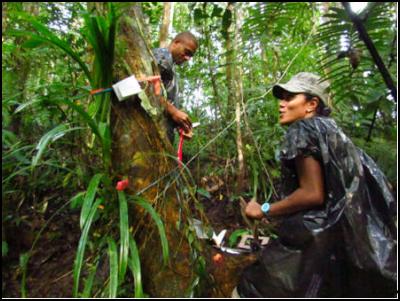New plant discovered in Fiji
4 February 2013
New plant discovered in Fiji

Graduate student researcher from IAS, Mereia Katafono conducting field work in the Vago Reserve in the Naitasiri Province, Fiji.
A new plant belonging to the non-vascular group of bryophyte plants was recently discovered in the lowlands of Viti Levu - Fiji’s largest island.
The genus called Cephaloziella has never been previously recorded in Fiji. A plant in this genus was found growing on the lower trunk of a tree fern in the Vago Reserve near Colo-i-Suva in the Naitasiri Province.
Cephaloziella belongs to the family Cephaloziellaceae, which is a group of very small, thread-like liverwort plants.
The discovery of the Cephaloziella liverwort was made by the Institute of Applied Science (IAS) at the University of the South Pacific by the Institute’s graduate student researcher, Mereia Katafono, and field assistants, Manoa Maiwaqa and Saula Mule.
The plant was found while conducting field work for Mereia’s Masters of Science research project on tree trunk-inhabiting bryophytes, a study which is a first of its kind in Fiji and in the region. The plant specimen was then identified by bryologists and external collaborators of the project, Dr Matt Renner of the National Herbarium of New South Wales, Sydney, Australia and Dr Matt von Konrat of the Field Museum of Natural History, Chicago, USA.
Liverworts are one of the three groups of bryophytes which are said to be the earliest green plants to move to land. Very little is known of this group of plants despite their great biological, ecological and evolutionary significance. They play an important role in ecosystem processes such as prevention of soil erosion, nutrient cycling, and forest hydrology. They may also contribute, as much as vascular plants, to species richness in many forests and can form a significant proportion of the total biomass of some plant communities.
Liverworts are also very sensitive to ecological and environmental changes, including anthropogenic disturbances. This has led to increased research in using bryophytes as indicators of long-term climate change and forest health hence supporting their usefulness in the field of conservation science.
This new record adds to the 48 new liverwort (species) records recently published by Pócs et al in 2011.
The finding of this new genus record potentially means more new species records for Fiji, said Mr Marika Tuiwawa, Curator of the South Pacific Regional Herbarium at IAS.
However, he added, that researchers are still determining if the plant represents a new species to science or if it is similar to a species known from New Zealand.
This new finding, according to Mr Tuiwawa, is another step forward in an effort to fill information gaps relating to Pacific bryophyte flora and in developing and strengthening bryophyte research in Fiji.
ENDS


 Business Canterbury: Urges Council To Cut Costs, Not Ambition For City
Business Canterbury: Urges Council To Cut Costs, Not Ambition For City Wellington Airport: On Track For Net Zero Emissions By 2028
Wellington Airport: On Track For Net Zero Emissions By 2028 Landcare Research: ANZAC Gall Fly Release Promises Natural Solution To Weed Threat
Landcare Research: ANZAC Gall Fly Release Promises Natural Solution To Weed Threat NZ Anti-Vivisection Society: Auckland Rat Lovers Unite!
NZ Anti-Vivisection Society: Auckland Rat Lovers Unite! University of Canterbury: $1.35 Million Grant To Study Lion-like Jumping Spiders
University of Canterbury: $1.35 Million Grant To Study Lion-like Jumping Spiders Federated Farmers: Government Ends War On Farming
Federated Farmers: Government Ends War On Farming



